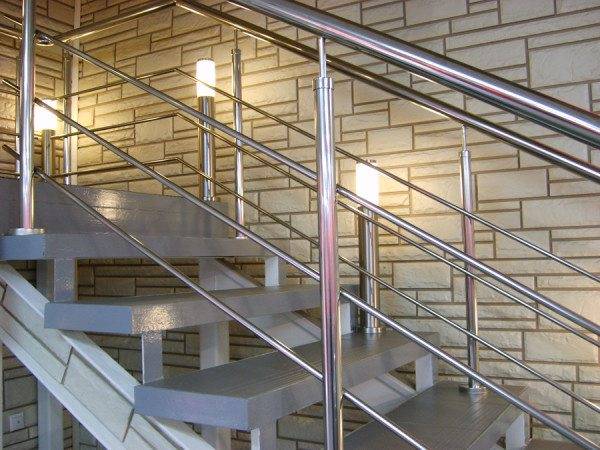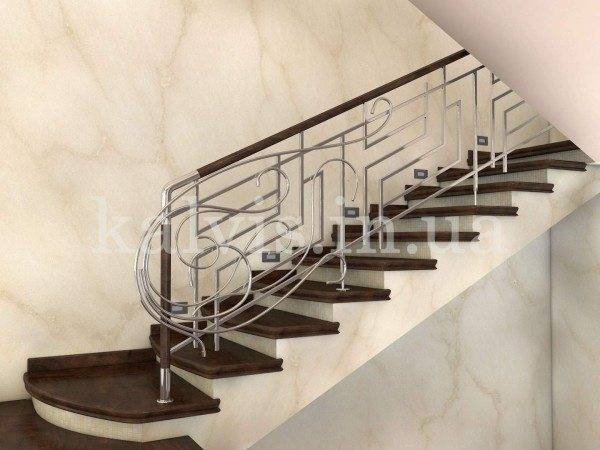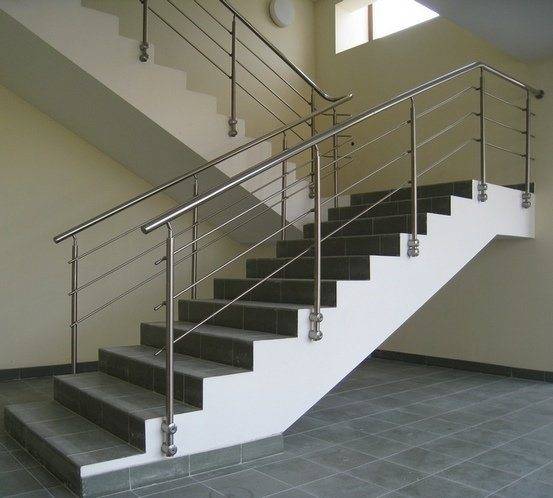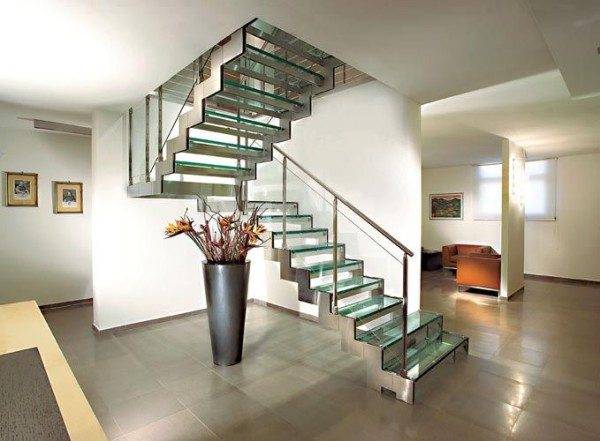The private sector is always distinguished by the possibility of using a wide variety of building materials, and therefore a variety in design, which is unacceptable for typical projects. So, in buildings with more than one floor, stainless steel is used for stair railings, which allows not only to diversify the design, but also to increase the mechanical strength and extend the life of the railings.
We will talk about this below, and also watch a video in this article on this topic.

Different designs of fences
Stair railings can serve not only as a protective barrier, but also be part of the base of the structure, for example, on boltsev and spiral staircases. Nevertheless, all of them must be made according to the requirements that are put forward by the safety instructions, as well as GOST 25772-83 (clauses 1.2, 1.3).
Requirements by Gosstandart

- One of the most basic requirements for fences of any type, if you do not take into account the strength standards, is their height and according to GOST 25772-83 (clauses 1.2, 1.3), it must be at least 900 mm... In addition, if there are three or more steps on the stairs, then according to SNiP 2.08.01-89 clause 1.17 and SNiP 2.08.02-89 clause 1.91, they must be fenced with handrails. The rules according to which the railings must be equipped (the presence of sharp corners, edges, and so on) are provided for in GOST 23120-78 (clauses 1, 2).
- For the installation of handrails on the steps of the stairs, the latter must withstand a load of at least 1.8 kN or 180 kgf... With a horizontal load or pressure on the handrails from the side, the balusters must withstand the fracture load, which, in the minimum order, will be 0.u54 kN or 54kgf. In addition to all these requirements, there are SNiP 2.03.11-85 (p. 5) and SNiP 3.04.03-85 (p. 2.1-2.8, 3), which provide resistance to fire and corrosion, which is quite consistent with stainless steel railings.
Advice. Of course, you will not invite a fireman or a technical engineer to check the railings when building a house or arranging a staircase during repairs, but you should take into account that force majeure circumstances can arise not only in a public building or production, but also in you at home.
Therefore, you can carry out an elementary check of the fences for a break with your own hands, using your own body weight.
Railings for staircases

- On marches, such structures are attached directly to the steps, stringer or bowstring, so the entire load is transferred to the staircase. In fact, the fastening of the balusters and their ability to withstand the fracture load are responsible for the strength of the railing. In the upper photo, the balusters are attached to the lateral plane of the stringer, which increases the contact area and, as a result, increases the resistance under lateral pressure. (see also the article How to make a ladder from metal with your own hands)

- The baluster can be fixed for stability with a heel or a metal bridge at the bottom of the rack. Such a heel can be attached to the steps on top by welding or bolts, but it can also be sunk into the concrete and welded to the reinforced frame of the step. (see also the article How the balusters of wooden stairs are fastened)

- Another way to create resistance to kink pressure is to mount a solid handrail in two directions - as you can see in the photo above. Here, tubular profiles made of stainless steel are the best suited, allowing you to create a monolith when joining.
- Please note that such a handrail arrangement with a lateral load on the upper flight will compensate for it by the vertical load on the lower flight. But if you press on the break of the baluster of the lower march, then compensation will occur at the top, since there will be a vertical pull-out load.

- Cables are sometimes used as horizontal jumpers, which are used instead of metal profiles and are installed either on clamping brackets or through holes in the balusters. In order not to create sagging, vertical posts are installed at least 1.2 m with a cable thickness of 3-6 mm.
Stainless steel railings on spiral staircases

- First of all, it should be noted the difference between spiral and spiral staircases, as they are often confused, or identified. So the screw structure can be based on stringers or bowstrings and can be attached in the same ways as on marches, while for the spiral base is a vertical support, most often in the form of a metal pipe, which is fixed to the floor and ceiling or to the wall , with the help of the upper step.
- For the spiral, handrails play an important role, since they are part of the frame, therefore, stainless steel pipe handrails are made monolithic. It turns out that the handrail, together with the balusters, is the part of the metal frame of the stairs opposite from the vertical base, therefore the bending of the tubular profile must be very accurate and repeat the contour of the stairs. Of course, you can order a ready-made structure of a certain diameter, but its price, of course, will be much higher.
Advice. If you want to make your own spiral from a stainless pipe, then you will certainly have to use a pipe bender.
Therefore, install the profile in the machine so that the seam is outside the convex part - this way you will avoid divergence.
Conclusion

If we talk about the quality of the material, then stainless stair railings are the best of all that are used for this purpose in everyday life and at work. When making such structures yourself, you should separately purchase accessories for assembly, that is, brackets, clamps, lugs and bolts. If they are not in the store, then any professional turner can do this job.






